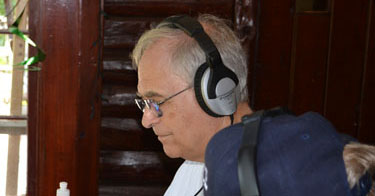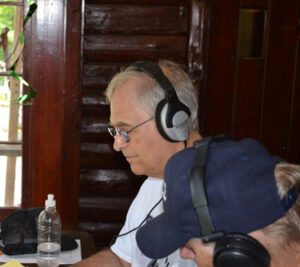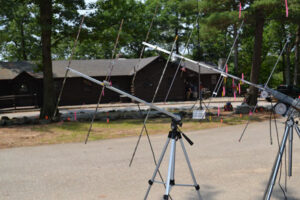
By Ann Needle

Ann Needle
With high tech just about everywhere, it is tough to imagine life without the magic of the Internet and cell phones. But, take these away, and there are dedicated amateur shortwave radio enthusiasts in Stow and surrounding communities ready to step in and help keep friends and neighbors in touch with what they need.
Welcome to the annual Field Day for amateur radio operators around the world. During this 24-hour period, on the fourth weekend in June, these operators dedicate themselves to seeing just how many fellow “hams” can be reached over the long distances that shortwave can bridge. This year’s local test was sponsored this past weekend by the Police Amateur Radio Team of Westford, at the Concord Rod and Gun Club. Local hams gathered with their radios, antennas, even portable solar panels, for the continuous, 24-hour test that officially began 2 p.m. Saturday.
About 25 hams were gathered Sunday morning, testing four shortwave stations. Two were using voice, another Morse code, and a fourth utilized digital technology. According to Stow’s Bob Glorioso, who was helping supervise the different stations, “We try to communicate with as many different people as we can.”
While radio chat throughout the year may be more relaxed outside of emergency situations, Glorioso noted that conversations with hams reached during the test were kept to brief, basic information. The group kept a running log of successful calls.
Shortwave operators communicate via a moving satellite. Most of those reached last weekend were located in the continental US and Canada. Glorioso mentioned that one station “almost” connected with some hams in Alaska and Hawai’i Saturday, but this year’s conditions were not as favorable as in some past tests. Members attributed that to various conditions, such as sunspot activity, that can interfere with satellite communications.
Still, as the weekend’s test showed, shortwave can hang on in most conditions, with Glorioso reporting about 700 hams contacted during the testing period.
The Shortwave Solution
It is shortwave’s ability to keep going when more sophisticated communications methods break down, that draws such stalwart enthusiasts, Glorioso said.
Given that ham operators are usually called on when commercial power is down, the weekend’s test conditions were designed to mimic emergency conditions as much as possible. Equipment was run only on batteries, and on very low frequencies of 5 watts or less. Glorioso mentioned, “When the power goes out, cell towers only have a 24-hour life.” The Concord test group was recharging its batteries with portable, fold-up solar panels, providing endless power to the equipment. (Some models also have built-in ability to run on solar power, or with a hand crank, and cost as little as $50.)
The most recent public example of hams stepping in was the Boston Marathon bombing, when cell reception was cut off briefly after the explosions. Ham radio operators were walking the route, keeping communication going, he said. Another local situation Glorioso and other hams pointed to that shortwave was well designed to handle was the 2009 ice storm, when some communities lost power for days.
Aside from emergencies, amateur radio technology provides some vital uses. One Police Amateur Radio Team members described how his wife — a fellow ham — used Morse Code to communicate with her father when he contracted ALS, lost his voice, yet refused to move out of his home in another state.

Ann Needle
Stow has its own community of about a dozen known ham operators, Glorioso estimated. He lauded Stow for its support of these operators, with the town allowing hams to hook into the fire station tower. “[Fire] Chief McLaughlin understands that, when there’s no power, they call us,” Glorioso remarked. Stow hams gather at the fire station for an emergency drill on the third Tuesday of every month, he added.
As for future plans, Glorioso said he is aiming to contact a ham operator in each of Stow’s neighborhoods. Currently, Glorioso said he knows of amateur radio coverage in the areas of Lake Boon, Birch Hill, and Bradley Lane. Also, Glorioso expressed hope that he could offer an amateur radio class of some kind come the Fall, and to work more closely with Stow’s Medical Reserve Corp.
Anyone interested in learning more about Stow ham radio can contact Glorioso at rglorioso@comcast.net.